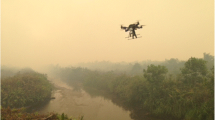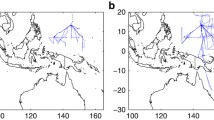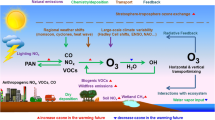Abstract
Fire emissions can strongly impact atmospheric abundances of trace gases and aerosols, in ways that vary strongly in time and space. There is emerging understanding that fires do not only influence areas in the lower troposphere, where the land-surface is in contact with the atmosphere, but can also have significant effects on the upper troposphere and even the stratosphere. Here, I will present example results from our ongoing global modelling studies investigating such effects. First, an overview of recent results will be presented, i.e. from (a) a case study on how high-altitude injections can influence stratospheric composition, and (b) a study that demonstrated how satellite observations can be used to understand the transport of fire pollution into the upper troposphere/lower stratosphere (UTLS), and how such measurements can be used to evaluate convective processes in composition-climate models. Subsequently, the role of typical low-injection fires in driving the interannual variability of UTLS composition will be discussed based on results from recent global model experiments, with a focus on impacts on CO and ozone. The findings show a major role of fire emissions in driving UTLS CO and a minor role in driving UTLS ozone interannual variability.
Access provided by CONRICYT-eBooks. Download conference paper PDF
Similar content being viewed by others
Keywords
These keywords were added by machine and not by the authors. This process is experimental and the keywords may be updated as the learning algorithm improves.
1 Introduction
Global modelling has so far almost entirely focused on the troposphere when it comes to impacts of fire emissions (Voulgarakis and Field 2015). There have been only a small number of isolated case studies of potential impacts on the stratosphere and the neighbouring upper troposphere (UT). Such impacts can arise either from the vertical transport of fire pollution emitted in the boundary layer into the UT and stratosphere (UT and S), or from the direct injection of emissions into the UT and S. Fire events with direct injection of emissions into the UT and S are rare; 90 % of emissions are estimated to be released below 3 km globally (Sofiev et al. 2013). However, since emissions that end up in the UT and S potentially have a very different lifetime and fate compared to those staying in the troposphere, and since the stratosphere is normally very pristine/clean, it is conceivable that such events could make a sizeable impact.
The signature of high injection events can appear alongside small volcanoes in terms of magnitude and lifetime (Vernier et al. 2011). They are, however more frequent especially at high latitudes (Fromm et al. 2010), comprised of substantial amounts of absorbing material, and therefore warrant independent investigation, especially with respect to their contribution to the stratospheric aerosol layer (Fromm et al. 2010). Their impacts may become more severe in the future (Trickl et al. 2013). Our recent work (Field et al. 2015a) has indicated that the evolution of pollution from high-injection events such as the Black Saturday fires in Australia (2009) can be simulated by a global composition-climate model (Fig. 1).
a Modelled CO in the UTLS (150–80 hPa) a few days after the Black Saturday fires (Australia), in a nearby region (NE of New Zealand); blue/red colours correspond to low/high emissions assumed (for CO and other fire-emitted species); asterisks are the same results but with Aura sampling/averaging kernels applied. Relationship between emissions amount & UTLS CO is linear. b Same but for three weeks after the fires, at a distant location (near Madagascar); after some weeks and far away from the source, there is a non-linear decrease in UTLS CO. c Same as b, but for CO deeper in the stratosphere (80–40 hPa); a non-linear CO increase is found (matching the UTLS CO decrease), either due to positive CO feedback on its lifetime via OH, or due to “self-lofting” of the plume via solar absorption by fire aerosols. (Results from our recent work (Field et al. 2015a))
Further work demonstrated the large impact of regular low-injection fire emissions from a severe event on upper tropospheric/lower stratospheric composition, with a focus on Indonesian fire emissions during El Nino conditions (Field et al. 2015b). That event was also used for studying how well different versions of a global model can capture such an event, and what is the role of the underlying model physics (Fig. 2).
Regional upper tropospheric CO for Aura, the GISS model AR5 simulation, and the AR5′ model simulation. The Aura operator has been applied to the model CO profiles. The large day-to-day variability is due to the location sampling of the Aura satellite operator. Solid line shows mean of 12 ensemble members, dashed lines show 1σ variation across members
Here, potential impacts of fire on upper tropospheric and stratospheric (UT&S) composition will be discussed using a preliminary analysis of GISS ModelE global model simulations.
2 Data and Methodology
We used the GISS ModelE composition-climate model, as described in Voulgarakis et al. (2015). The models has a 2º latitude by 2.5º longitude horizontal resolution and 40 vertical layers from the surface to 0.1 hPa. The model’s chemistry includes 156 chemical reactions among 51 gas species. Tropospheric chemistry includes basic NOx-HOx-Ox-CO-CH4 chemistry as well as PANs and the hydrocarbons isoprene, alkyl nitrates, aldehydes, alkenes, and paraffins. The lumped hydrocarbon family scheme was derived from the Carbon Bond Mechanism-4 (CBM-4) and from the more extensive Regional Atmospheric Chemistry Model (RACM). To represent stratospheric chemistry, the model includes chlorine—and bromine-containing compounds, and CFC and N2O source gases. Photolysis rates are simulated using the Fast-J2 scheme, which accounts for the effects of modelled overhead ozone, clouds, aerosols and surface reflections. The aerosol scheme includes prognostic simulations of the mass distributions of sulfate, sea-salt, dust and carbonaceous aerosols. Secondary organic aerosol production depends on modelled isoprene and terpenes as oxidized by OH, ozone, and nitrate radicals.
We performed two 1997–2009 simulations (with two years of spin-up before 1997): (a) BASE, which has interannually varying fire emissions and meteorology (via observed SSTs and nudged meteorology); and (b) BBfix, in which 1997–2009 average fire emissions were repeated every year. Comparing BASE with BBfix will inform on the role of fires in driving interannual variability. Fire emissions come from the Global Fire Emissions Database 3 (GFED3), and were assumed to be uniformly mixed throughout the boundary layer, whose height is calculated online at every model timestep. Anthropogenic emissions come from the Atmospheric Chemistry and Climate Model Intercomparison Project (ACCMIP), and vary from decade to decade, with linear interpolation for intermediate years. Biogenic isoprene emissions are a function of vegetation type and leaf area index with responses to temperature and solar radiation, while terpene emissions come from the output of the OCHIDEE model, and do not vary interannually. Lightning NOx emissions depend on the climate model’s convection. Well-mixed greenhouse gas concentrations vary according to global mean observed values. This version of the model was evaluated when it comes to capturing both the mean state and the interannual variability of key tropospheric constituents and was found to have good skill (e.g. Voulgarakis et al. 2015).
3 Results
In the same way as was done by Voulgarakis et al. (2010) and Voulgarakis et al. (2015) for tropospheric composition, the BASE and the BBFix simulations were compared to isolate the role of emissions specifically from fires in driving the global and regional variability of key pollutants such as CO and ozone. Here, the focus is not the bulk of the troposphere, as in previous studies, but the UT and S.
Figure 3 shows the results for CO, which is found to be the constituent that is affected most by fire emissions. The left hand panel shows the behavior of tropospheric CO burden, for reference, whose interannual variability appeared to be entirely driven by fire emissions. When moving to areas that roughly correspond to the upper troposphere (300–200 hPa), the effect of fires is still dominant. It is also notable that the variability of global upper tropospheric CO is very similar to that of total tropospheric CO, with ENSO cycles still dominating it at those high altitudes. Even more remarkably, fire emissions are found to be the major driver of CO variability between 200–100 hPa (~lower stratosphere).
Percentage deviations (%) from the 13-year mean for global annual tropospheric (upper left), upper tropospheric (350–200 hPa; upper right), and lower stratospheric (200-100 hPa; lower) CO burden for the BASE (black) and BBFix (red) simulations. Overplotted in the upper left panel are the global total CO fire emissions (dotted)
We also show here equivalent figures for the ozone burden. As it is obvious from the plots, the impact of fires on UT and S ozone is less pronounced (Fig. 4).
4 Conclusions
We approach a largely unexplored issue, i.e. the impact of fire emissions on the upper troposphere and stratosphere. Our recent work has shown that significant fire events can strongly perturb the short-term atmospheric composition of those areas. Our new results presented here demonstrate that even in a time-average context, fires are capable of drastically affecting UT&S composition and its variability from year to year. However, this conclusion depends on the constituent under study: For CO, we find that the fire effect is dominant, while for ozone, we find that the effect is relatively minor. More studies are required in the future to examine such effects in different models, and especially to constrain such effects via observational analysis. Furthermore, it is our future plan to examine other important constituents in the UT and S, such as carbonaceous aerosols, NOx and OH.
References
Field RD, Luo M, Fromm M, Voulgarakis A, Mangeon S, Worden (2015a) Simulating the black saturday 2009 smoke plume with an interactive composition-climate model: sensitivity to emissions amount, timing and injection height, J Geophys Res, accepted
Field RD, Luo M, Kim D, Del Genio AD, Voulgarakis A, Worden J (2015b) Sensitivity of simulated tropospheric CO to subgrid physics parameterization: a case study of Indonesian biomass burning emissions in 2006. J Geophys Res 120:11743–11759. doi:10.1002/2015JD023402
Fromm M, Lindsey DT, Servranckx R, Yue G, Trickl T, Sica R, Doucet E, Godin-Beekmann SE (2010) The Untold Story of Pyrocumulonimbus. B Am Meteorol Soc 91(9):1193–1209. doi:10.1175/2010bams3004.1
Sofiev M, Vankevich R, Ermakova T, Hakkarainen J (2013) Global mapping of maximum emission heights and resulting vertical profiles of wildfire emissions. Atmos Chem Phys 13(14):7039–7052. doi:10.5194/acp-13-7039-2013
Trickl T, Giehl H, Jaeger H, Vogelmann H (2013) 35 yr of stratospheric aerosol measurements at Garmisch-Partenkirchen: from Fuego to Eyjafjallajokull, and beyond. Atmos Chem Phys 13(10):5205–5225. doi:10.5194/acp-13-5205-2013
Vernier JP, Pommereau JP, Thomason LW, Pelon J, Garnier A, Deshler T, Jumelet J, Nielsen JK (2011) Overshooting of clean tropospheric air in the tropical lower stratosphere as seen by the CALIPSO lidar. Atmos Chem Phys 11(18):9683–9696. doi:10.5194/acp-11-9683-2011
Voulgarakis A, Savage NH, Wild O, Braesicke P, Carver GD, Pyle JA (2010) Interannual varia-bility of tropospheric composition: the influence of changes in emissions, meteorology and clouds. Atmos Chem Phys 10:2491–2506. doi:10.5194/acp-10-2491-2010
Voulgarakis A, Field RF (2015) Fire influences on atmospheric composition, air quality, and climate. Curr Pollut Rep 1(2):70–81. doi:10.1007/s40726-015-0007-z
Voulgarakis A, Marlier ME, Faluvegi G, Shindell DT, Tsigaridis K, Mangeon S (2015) Interan-nual variability of tropospheric trace gases and aerosols: The role of biomass burning emissions. J Geophys Res 120(14):7157–7173. doi:10.1002/2014JD022926
Acknowledgments
The authors wish to thank NASA ACMAP for funding and the NASA High-End Computing (HEC) Program for computation resources through the NASA Center for Climate Simulation (NCCS) at Goddard Space Flight Center. Also, the authors thank the European Commission’s Marie Curie International Research Staff Exchange Scheme (IRSES) for funding under the project titled “Regional climate-air quality interactions (REQUA)”.
Author information
Authors and Affiliations
Corresponding author
Editor information
Editors and Affiliations
Rights and permissions
Copyright information
© 2017 Springer International Publishing Switzerland
About this paper
Cite this paper
Voulgarakis, A., Field, R., Fromm, M. (2017). Fire Impacts on High-Altitude Atmospheric Com-Position. In: Karacostas, T., Bais, A., Nastos, P. (eds) Perspectives on Atmospheric Sciences. Springer Atmospheric Sciences. Springer, Cham. https://doi.org/10.1007/978-3-319-35095-0_177
Download citation
DOI: https://doi.org/10.1007/978-3-319-35095-0_177
Published:
Publisher Name: Springer, Cham
Print ISBN: 978-3-319-35094-3
Online ISBN: 978-3-319-35095-0
eBook Packages: Earth and Environmental ScienceEarth and Environmental Science (R0)








